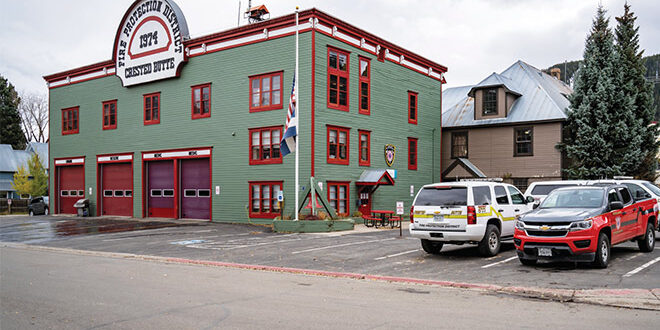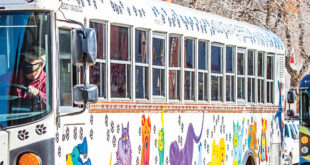Size and timing questions
[ by Mark Reaman ]
At the start of the Crested Butte News Candidates Forum, the topic of ballot issue 6A was discussed. Crested Butte Fire Protection District (CBFPD) CEO Sean Caffrey and Crested Butte Mountain Rescue Team board member Kemble Widmer gave an overview of the need for and the plan to provide more room for both organizations, which are cramped in their current spaces.
Caffrey explained the idea is to use land provided by the town in the Slate River subdivision on Crested Butte’s north side along with some acreage from the Spann Ranches adjacent to the town parcel. A campus that includes a 31,000 square foot fire station along with a 9,000 square foot Mountain Rescue building and 5,000 square foot affordable housing building would be located along Gothic Road near Pyramid Avenue in front of the Aperture subdivision. Caffrey said the idea is to consolidate the district’s operations to a main building and provide sleeping quarters for on-duty, overnight emergency personnel. About 12,000 square feet of the main building would be used for vehicle storage. He said the facility is meant to accommodate the district’s needs for the next 50 years. The additional mill levy would add about $230 annually to the property tax bill of a house in the district valued at $1 million.
Widmer said the search and rescue team is basically working out of a one-room shack and as the number of volunteers increases, the building is becoming too cramped. It also does not allow a place to store vehicles so many volunteer hours are spent cleaning off the vehicles to keep them mission-ready in the winter.
Citizen Jim Starr said while he appreciates the work of both organizations, the mill levy increase request seemed too much. “It seems like a Taj Mahal to me,” he said. “Search and rescue would seem good with 3,000 or 4,000 square feet. It seems both are way over-built.”
Former Crested Butte planner John Hess agreed. “Is there any way to break up the big buildings into smaller ones,” he asked.
Caffrey said the district officials took a “hard look” at the size but operations were driving the square footage. He cited the desire to keep overnight crews in the new building instead of splitting them up at the Crested Butte South and Mt. Crested Butte stations. He said the size when compared to places like Snowmass, Carbondale and the new Gunnison proposal was similar. Widmer said his research with other Colorado search and rescue teams provided similar comparisons. “Based on the number of missions we do, the square footage seems about right,” he said. “Another consideration was that we didn’t want to have to come back to the citizens in 10 or 15 years and ask for more money.”
In response to another question, Caffrey said there would be a meeting room that could be used by the community.
Given the many questions we’ve heard about the proposal, we sent Caffrey and Widmer some more questions and asked for details. Here are the responses:
How much will the bond issue 6A raise and what will the money be used for?
The total amount borrowed will be less than $26 million. The project will include land, site work and three buildings. The ballot language very specifically calls out the project features including:
• Land Acquisition
• Construction of a four-bay fire and ambulance station
• Construction of a search and rescue facility
• Construction of four employee housing units for emergency services personnel
• Sustainability features including solar panels
• Training facility and features if funds are available
The funds are exclusively for new facilities that will benefit the community in the form of faster response times and the ability to compete for qualified personnel. No operating costs, personnel or vehicles are included with this request as we anticipate our operating funds will be sufficient moving forward to support those items.
Didn’t the CBFPD recently ask for and get a bond issue in the last several years? How much is that bringing in and where is that money allocated?
The CBFPD asked for a 3.5 mill increase in our operating levy in 2017 that was approved by voters and raises approximately $1.1 million annually. Those funds were used to hire additional paid firefighters and paramedics as promised. Since 2017 our response times have been cut in half thanks to this expanded staffing.
What are the district’s reserve fund balances right now? What is the trend for them? Have they been shrinking or increasing in the last three or four years?
The District currently has about $2.5 million in reserves. This is down from about $4 million in 2019 mostly due to the acquisition of four employee housing units in 2020 which had been planned for over a decade.
Why do you need to go from about 4,500 square feet in CB for vehicle storage and offices to 31,000? Why is there a need for 6X the current space?
Our current station at 306 Maroon Avenue was built 47 years ago for a mission that no longer resembles our reality and thus is inappropriate as a basis for comparison. In 1974 there was no ambulance/Emergency Management Services (EMS) as part of the mission, there were no employees, no overnight presence, only two offices, and the tactics, techniques and necessary infrastructure to support modern day fire operations had not yet been contemplated. In designing our new facility, we started with the functional requirements necessary to fulfill firefighting and EMS missions in the year 2021.
This includes basic, functional design elements such as accommodation and facilities for multiple overnight personnel providing immediate 24 x 7 response, training rooms sized to accommodate all personnel and maintain the latest skillsets, offices for our employees to effectively administer the organization, storage rooms to house our mission critical equipment, and vehicle bays to effectively house and maintain much of our current fleet in a centralized location to improve response times. Once this functional design was complete including accommodation for inevitable growth in coming years, we cut certain items from the design we felt weren’t absolutely necessary and then compared our design to comparable fire missions in 2021, which we believe the only appropriate basis of comparison. On this score, our size of 31,000 square feet is smaller than headquarters with similar mission profiles in Carbondale, Snowmass and newly proposed in Gunnison. Importantly, our facility is not just fire, but EMS as well.
How much acreage is being used for the new campus and what’s the total proposed square feet of all the buildings on the property?
The total site is approximately 3.5 acres. The estimated square footage of the buildings is 30,800 sq. ft. for the Fire and EMS station. 9,000 sq. ft. for the Crested Butte Mountain Rescue Team (CBMRT) facility and 5,000 sq. ft. for the housing units. A training facility, if built, will be located at a different site. The vast majority of square footage in the Fire and CBMRT buildings is for covered vehicle parking.
What is the plan for the district buildings in CB South, Mt. CB and Buckhorn if 6A passes?
6A will allow us to re-organize our fleet to improve mission response times by placing more equipment at the new centralized headquarters, which will in turn free up additional space for indoor parking of emergency vehicles at our outlying stations. In particular we plan to move our ladder truck, a water tanker, and a wildfire truck to the main facility as we frequently have to fetch those from distant locations as the situation demands. Small improvements in response time can make the critical difference in extinguishing a wildland fire before it reaches homes, as we saw in the recent wildland fire off Route 135. As the district continues to grow we will likely place two response personnel at the CB South Station due to its distance from town and the availability of space and bedrooms.
What is the plan for the Third and Maroon building if it passes?
306 Maroon Avenue is owned by the Town of Crested Butte so its ultimate use will be up to the Town Council. We understand there is talk of relocating the Marshal’s Office to that space if it becomes available.
Why is it important that 6A passes now?
The current fire station presents an unacceptable constraint on the fire district fulfilling its mission, particularly given recent and future growth. The current CBMRT headquarters (a barn) is grossly inferior to what comparable SAR teams have currently, and their missions were up 80 percent last year alone. Due to the foresight of town council, the generosity of the Spanns and the fire board’s negotiations, we have secured 3.5 acres for a fraction of market value, saving taxpayers $3M in land acquisition cost. Interest rates are at historical lows saving the taxpayers much more if we are able to secure funding now before interest rates and construction costs rise further. A yes vote on 6A locks in these savings and unlocks our respective teams’ building constraints. Growth and increased fire risk of a changing climate is here; help our teams meet it.
Will the issue result in an insurance savings for people?
It’s possible that fire insurance premiums could go down, but that’s unclear. The proposed new station is a replacement of a current facility and most fire insurance premiums are based on distance from a fire station and availability of fire hydrants near the property being insured. District-wide we currently have an excellent fire insurance rating for a rural area that is a 3 on a 1 -10 scale with 1 being best.
 The Crested Butte News Serving the Gunnison Valley since 1999
The Crested Butte News Serving the Gunnison Valley since 1999



